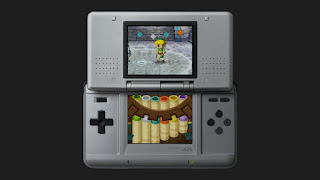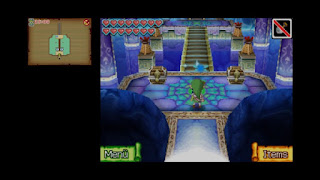This review was originally published on ZeldaChronicles (formerly known as ZeldaEurope) and got translated for this blog in 2022 by the same author. Nintendo had provided a download code.
On November 13th both The Legend of Zelda: Phantom Hourglass and The Legend of Zelda: Spirit Tracks, the two Nintendo DS Zelda titles, became available on the Wii U eShop for 9.99€ each. Let's take a look at how both games play on the current home console and what you will have to keep in mind before purchasing. Both games got fully completed for this review.
Full Steam Back!
Phantom Hourglass and Spirit Tracks were originally released for the Nintendo DS in 2007 and 2009 respectively. And thanks to their touchscreen controls, they are amongst the more controversial Zelda games. Regardless of whether you like the stylus-only input or not, the games offered some other weird ideas and concepts in addition...
Phantom Hourglass is the direct sequel to The Wind Waker and takes places on the ocean as well. But this time you're traveling on a steam boat, whose course has to be drawn on the map. To obtain the required sea charts you will have to visit the infamous Temple of the Ocean King multiple times, an enormous dungeon with a total of 14 floors, where initially you can only explore a few of them. These floors are patrolled by the so-called Phantoms, invincible enemies that you need to avoid. Also, the temple will drain your life energy, unless you are inside a safe zone or there is still sand running through the eponymous Phantom Hourglass, which essentially adds a time limit to the dungeon. Needless to say that the Temple of the Ocean King is quite controversial: some hated it, others welcomed the challenge (where the dungeon at least had some, unlike the other temples in the game). Other things of note are Linebeck's prominent character, the excellent Spirit Orb collectible, as well as the rather minimalistic soundtrack.
Spirit Tracks on the other hand was a lot more melodic, where two years after the release of Phantom Hourglass Nintendo took up its game mechanics again and tried to implement them in a different way. Instead of a steam boat, you now take control of a steam train in order to reach new areas. Before you can do that, you need to get the Rail Maps from the Tower of Spirits, this game's central dungeon. Unlike the Temple of the Ocean King, however, you don't have to repeat the same sections multiple times and there is no clock running in the background. Plus, you now can also take control of a Phantom, one at a time, which leads to some unique gameplay ideas, where you have to play cooperatively. Partly, some of those ideas were even brought back in Tri Force Heroes with its "Totem" mechanik. On the other hand Spirit Tracks is much more linear, gated, and slower than its predecessor, for a rather dull game experience with little freedom.
So, both games have their similarities, differences, strengths, and weaknesses. And you can now discover for yourself which one you prefer on the Wii U, where both titles have been released simultaneously for the Virtual Console.
Return on the Wii U GamePad
Once you're playing Phantom Hourglass or Spirit Tracks on the Wii U GamePad, which is the only option because of the touchscreen controls, you will quickly get the feeling that both games should probably be on top of Nintendo's list for potential remakes. The pixelated 3D graphics haven't aged well at all and you will clearly notice the lower frame rate (despite it being stable), especially if you have played Tri Force Heroes right before, which is simply much better on these regards. The Nintendo 3DS game(s) will also make you miss their more traditional controls, where you steer Link via the analogue stick. While the touchscreen controls were a good choice for the Nintendo DS, since the games wouldn't have played as well with the D-pad alone, it's a different story with the Wii U GamePad in your hand(s), which is much larger and heavier than the Nintendo DS and therefore makes playing with the stylus in one hand quite uncomfortable.
Since Virtual Console games only get emulated and not ported, you will either have to make do with the touchscreen controls or wait for an actual remake. If you pick up the Virtual Console versions, however, then it will be advised to support the GamePad somehow, e.g. on a table or your lap. And you should definitely install one of Nintendo's screen protectors, because the many sword strikes with the stylus will leave small scratches.
If you follow these advice, then it will play mostly fine, and you also get all possible screen settings. You can split things, so that the Nintendo DS touchscreen is fully on the Wii U GamePad and the upper Nintendo DS screen gets displayed on the TV. Otherwise there are six different configurations for having both screens on the GamePad (and TV), where four of them come with support for left- and right-handed modes.
One even lets you use the Wii U GamePad vertically, which makes best use of the screen size and can be quite comfortable with the GamePad resting on your lap or a table. The option to have one screen in a bigger size and the other small next to it is also interesting. Since the upper screen gets mostly used for displaying the map in the Nintendo DS Zelda games, it's a good choice for using the GamePad horizontally, at least for the most part.
However, there is no option to display both screens right next to each other without a gap. This is fine with Phantom Hourglass, because the game takes a gap into account for displaying scenes that go over both screens, e.g. certain boss battles or the shooting gallery. But Spirit Tracks doesn't do the same and here it would have been nice if there were an option to remove or reduce the gap, so that these scenes look better. But this was already an issue with the original game.
Another problem with the original Spirit Tracks have been frame drops on the Nintendo DS, e.g. when being attacked by those tanks. But the game runs smoothly on the Virtual Console, which is fantastic.
Sadly, all those display options came at the expense of the usual controller setting, where you can freely change your button layout. For some reason this not possible with the Nintendo DS games any longer. Of course, with Phantom Hourglass and Spirit Tracks it's not a big deal, because you will play via the touchscreen the entire time. But having the Virtual Console menu on ZR can be an issue whenever your GamePad rests on something while playing, because then the menu might be accidentally triggered. And here it would have been good if you could simply assign it to a different button.
All things considered, Phantom Hourglass actually plays quite nicely on the Wii U GamePad, where it was fun to play through the game via the Virtual Console once more. Spirit Tracks on the other hand doesn't get along with the microphone of the Wii U GamePad, especially when you want to play the Spirit Flute. Already with the Whirlwind item you will notice that you have to blow quite strongly in order for it to work, but playing the flute feels like a physical impossibility, because the GamePad won't allow for continuous blows...
There already have been similar issues on the Nintendo 3DS, which may be caused by the integrated noise cancellation of the microphone, which makes it impossible to play the Spirit Flute like you could on the older Nintendo DS models. And this creates a frustrating obstacle, where you just want to put the game aside... The Wii U also doesn't give you any options for configuring the microphone, but Nintendo really should have done something to make the game work, e.g. a button to simulate microphone input.
Curiosities
If you're familiar with Phantom Hourglass, then you will know about the infamous puzzle where you had to close your Nintendo DS. The Nintendo 2DS already had the same problem and the solution is also the same: you activate the Sleep Mode, which in this case gets achieved by calling the Virtual Console menu. This gets noted in the Virtual Console manual, but there are no hints about this in the game, which will certainly cause some confusions.
Also confusing may be some orphaned features in the games, specifically the Battle and Tag Modes. This gets addressed in the manual as well, but nothing was done to make them inaccessible, unlike in Oracle of Ages & Seasons on the 3DS Virtual Console, where you couldn't talk to the Blue Snake and so on. Quite the opposite, Phantom Hourglass even lets you open the Wi-Fi settings of the Nintendo DS! This is of no use, of course, because you can't play Virtual Console games online on the Wii U. But in the least Nintendo could have removed the menu entries in the game, so you won't be baffled by it in the first place.
The Tag Mode, which basically was a predecessor for StreetPass, also can't be used any longer, so you won't have the possibility to trade treasures and Ship Parts with other players. This may not seem like a problem at first, because you technically can find everything on your own, but the probabilities for them are biased, so that you will find certain treasures more often than others, which is different for every save file. This was to encourage you to use the Tag Mode and quite a problem a in Spirit Tracks, where getting all the necessary treasures for the Train Cars is a grind otherwise.
Luckily, you can use the Virtual Console Restore Point to put your luck a little more in the right way by reloading your game right before getting a treasure, until you get whatever you need. But even such methods will only help you so much.
The internal clock of the Nintendo DS also takes a role in collecting things, where the shop offers of treasures and Ship Parts change every day and the Masked Ship only appears at certain times. The Suspension and Restore Points will save the time when they got created, however. This makes sense from a technical point of view, but can be confusing at first. To synchronize the internal clock of the Nintendo DS emulator with that of your Wii U again you will simply have to reset the game via the Virtual Console menu. But don't forget to save within the game before that.
Conclusion
Phantom Hourglass and Spirit Tracks were clearly optimized for being played on the Nintendo DS and if you have the choice, then you should go for the originals. Thanks to the extensive screen settings it's still quite enjoyable to play Phantom Hourglass on the Wii U, but the same can't be said about Spirit Tracks, where Nintendo needs to do something about the microphone issues.
The Good:
- Lots of screen settings
- No drops in the frame rate
The Bad:
- Microphone issues in Spirit Tracks
- No controller settings
- Orphaned multiplayer functions







No comments:
Post a Comment